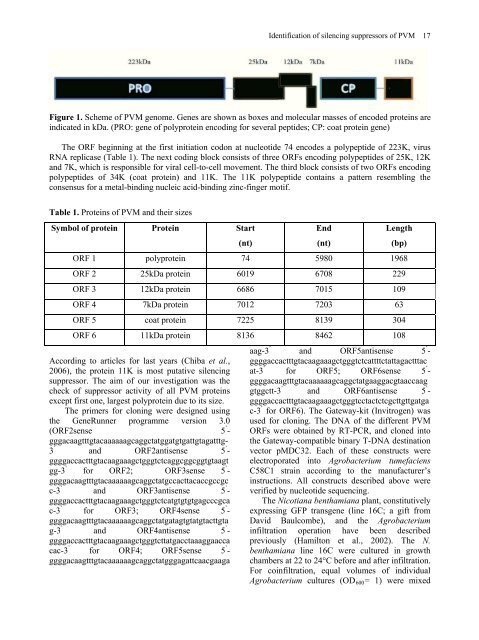Vol 9 No1 - Journal of Cell and Molecular Biology - Haliç Üniversitesi
Vol 9 No1 - Journal of Cell and Molecular Biology - Haliç Üniversitesi
Vol 9 No1 - Journal of Cell and Molecular Biology - Haliç Üniversitesi
Create successful ePaper yourself
Turn your PDF publications into a flip-book with our unique Google optimized e-Paper software.
Identification <strong>of</strong> silencing suppressors <strong>of</strong> PVM 17<br />
Figure 1. Scheme <strong>of</strong> PVM genome. Genes are shown as boxes <strong>and</strong> molecular masses <strong>of</strong> encoded proteins are<br />
indicated in kDa. (PRO: gene <strong>of</strong> polyprotein encoding for several peptides; CP: coat protein gene)<br />
The ORF beginning at the first initiation codon at nucleotide 74 encodes a polypeptide <strong>of</strong> 223K, virus<br />
RNA replicase (Table 1). The next coding block consists <strong>of</strong> three ORFs encoding polypeptides <strong>of</strong> 25K, 12K<br />
<strong>and</strong> 7K, which is responsible for viral cell-to-cell movement. The third block consists <strong>of</strong> two ORFs encoding<br />
polypeptides <strong>of</strong> 34K (coat protein) <strong>and</strong> 11K. The 11K polypeptide contains a pattern resembling the<br />
consensus for a metal-binding nucleic acid-binding zinc-finger motif.<br />
Table 1. Proteins <strong>of</strong> PVM <strong>and</strong> their sizes<br />
Symbol <strong>of</strong> protein Protein Start<br />
End<br />
Length<br />
(nt)<br />
(nt)<br />
(bp)<br />
ORF 1 polyprotein 74 5980 1968<br />
ORF 2 25kDa protein 6019 6708 229<br />
ORF 3 12kDa protein 6686 7015 109<br />
ORF 4 7kDa protein 7012 7203 63<br />
ORF 5 coat protein 7225 8139 304<br />
ORF 6 11kDa protein 8136 8462 108<br />
According to articles for last years (Chiba et al.,<br />
2006), the protein 11K is most putative silencing<br />
suppressor. The aim <strong>of</strong> our investigation was the<br />
check <strong>of</strong> suppressor activity <strong>of</strong> all PVM proteins<br />
except first one, largest polyprotein due to its size.<br />
The primers for cloning were designed using<br />
the GeneRunner programme version 3.0<br />
(ORF2sense 5 ’ -<br />
gggacaagtttgtacaaaaaagcaggctatggatgtgattgtagatttg-<br />
3 ’ <strong>and</strong> ORF2antisense 5 ’ -<br />
ggggaccactttgtacaagaaagctgggtctcaggcggcggtgtaagt<br />
gg-3 ’ for ORF2; ORF3sense 5 ’ -<br />
ggggacaagtttgtacaaaaaagcaggctatgccacttacaccgccgc<br />
c-3 ’ <strong>and</strong> ORF3antisense 5 ’ -<br />
ggggaccactttgtacaagaaagctgggtctcatgtgtgtgagcccgca<br />
c-3 ’ for ORF3; ORF4sense 5 ’ -<br />
ggggacaagtttgtacaaaaaagcaggctatgatagtgtatgtacttgta<br />
g-3 ’ <strong>and</strong> ORF4antisense 5 ’ -<br />
ggggaccactttgtacaagaaagctgggtcttatgacctaaaggaacca<br />
cac-3 ’ for ORF4; ORF5sense 5 ’ -<br />
ggggacaagtttgtacaaaaaagcaggctatgggagattcaacgaaga<br />
aag-3 ’ <strong>and</strong> ORF5antisense 5 ’ -<br />
ggggaccactttgtacaagaaagctgggtctcattttctattagactttac<br />
at-3 ’ for ORF5; ORF6sense 5 ’ -<br />
ggggacaagtttgtacaaaaaagcaggctatgaaggacgtaaccaag<br />
gtggctt-3 ’ <strong>and</strong> ORF6antisense 5 ’ -<br />
ggggaccactttgtacaagaaagctgggtcctactctcgcttgttgatga<br />
c-3 ’ for ORF6). The Gateway-kit (Invitrogen) was<br />
used for cloning. The DNA <strong>of</strong> the different PVM<br />
ORFs were obtained by RT-PCR, <strong>and</strong> cloned into<br />
the Gateway-compatible binary T-DNA destination<br />
vector pMDC32. Each <strong>of</strong> these constructs were<br />
electroporated into Agrobacterium tumefaciens<br />
C58C1 strain according to the manufacturer’s<br />
instructions. All constructs described above were<br />
verified by nucleotide sequencing.<br />
The Nicotiana benthamiana plant, constitutively<br />
expressing GFP transgene (line 16C; a gift from<br />
David Baulcombe), <strong>and</strong> the Agrobacterium<br />
infiltration operation have been described<br />
previously (Hamilton et al., 2002). The N.<br />
benthamiana line 16C were cultured in growth<br />
chambers at 22 to 24°C before <strong>and</strong> after infiltration.<br />
For coinfiltration, equal volumes <strong>of</strong> individual<br />
Agrobacterium cultures (OD600= 1) were mixed

















